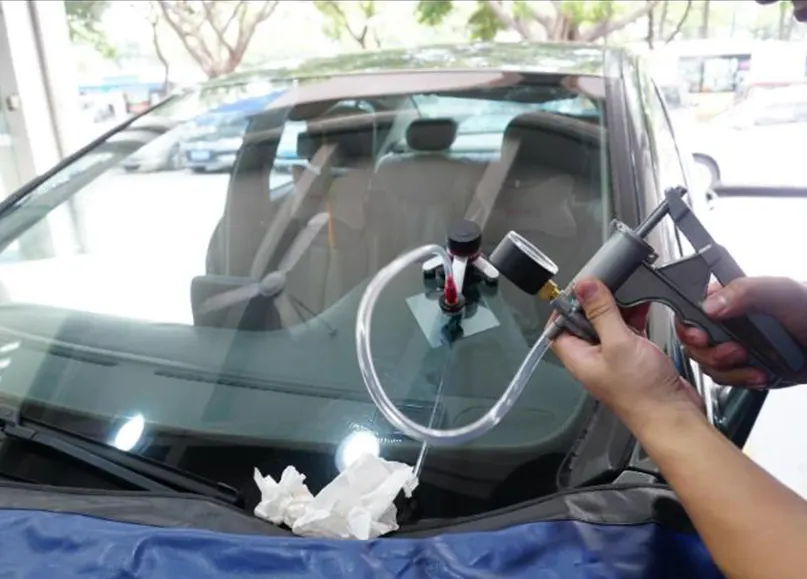For a long time, there has been a wrong view in the field of automobile maintenance in China, that glass glue is an insignificant automotive accessories, and even insufficient attention has been paid to it, resulting in low-fat adhesives or architectural glass adhesives flooding the automotive glass replacement market, causing great safety hazards to the repaired accident vehicles.
Glass glue is a material that bonds and seals various types of glass with other substrates. It is mainly divided into two categories: silicone adhesive and polyurethane adhesive (PU) – Baidu Encyclopedia one-component polyurethane adhesive for automotive window glass – a paste mixed with polyurethane prepolymer as the main component and other auxiliary materials, which is cured by moisture after extrusion to form an elastomer that has an adhesive sealing effect on automobile window glass – HG/T 4363-2012
The glass glue used in automobile windshields is one-component polyurethane glass glue. Why is polyurethane glass glue the patron saint of automobile windshields? Because once it is not selected or used properly, it will lead to the fall off of the front and rear windshields, and there will be unpredictable safety hazards. There are two brothers in polyurethane adhesive sealants, which are called cleaning activators and primers.
Product Features (Requirements)
(1) One-component, moisture-curing;
(2) Good thixotropy, the façade does not collapse when glued;
(3) No corrosion and no impact on glass and organic coatings;
(4) Aging resistance, water resistance, salt spray resistance, vibration fatigue resistance, weak acid and alkali resistance, short-term resistance to fuel oil, minerals, vegetable oil;
(5) Good heat resistance, low temperature resistance, low temperature no cracks.
Curing principle
Polyurethane adhesive sealant reacts chemically with moisture in the air to form a high-strength elastic adhesive seal.
Directions for use
(1) Cleaning of adhesive parts
Pour the supporting cleaning agent into a clean and dry construction container and immediately cover and seal the original packaging, then dip the cleaning agent with a clean absorbent cotton or absorbent cotton brush, and wipe it along the glass and window frame to be bonded (note: do not miss the wipe or wipe back and forth multiple times, and replace it in time when the wiping cotton cloth changes color) to dry it naturally, and ensure that the surface is free of grease, dust and other impurities during construction; Clean the sticky area.
(2) Apply the primer evenly
Before using the primer, it must be fully shaken until the impact of the steel ball can be heard, poured into a clean and dry construction container, and immediately close the original primer container, and then use a cotton ball or cotton brush to evenly coat the primer in a clockwise direction in the cleaned glass or body paint bonding part, and the primer width is 1.5~2.0 times of the bonding width. Try to coat evenly and thinly (generally with a thickness of 8-20um, anti-ultraviolet irradiation glass glue) under the condition of not revealing the white bottom, let it dry naturally for about 3min, and then apply the sizing. (Note: Do not spray the primer, and it is strictly forbidden for all objects to contact the surface of the substrate that has been coated with primer).
(3) Gluing
1. Tie the mouth of the rubber cylinder with a screwdriver and other tools, cut the mouth of the rubber into a triangle, tighten it on the mouth of the rubber cylinder, uncover the bottom of the rubber cylinder, and load it into the glue gun; If the manipulator is used to apply sizing, adjust the manipulator trajectory;
2. Use a glue gun or manipulator to apply the glue to the primed window frame or the gluing part of the glass, the shape of the rubber strip is triangular, the bottom edge is about 10mm wide, and the height is 12-14mm;
3. The window glass should be assembled immediately after gluing, the gap should be adjusted, and the position should not be moved in tandem as much as possible, and then the glass should be fixed with pressure-sensitive tape or other fixtures.
Conditions of Use
(1) The workplace is well ventilated and illuminated;
(2) Construction conditions: temperature 10~40°C, humidity 40~80%RH; If the construction temperature is lower than 10 °C, it is best to use a rubber dryer to adjust 25 °C and bake for more than 2 hours, and when the temperature is > 40 °C, the humidity > 85%RH, please be cautious in construction;
(3) Dust-free workshop;
(4) The work of gluing and bonding generally takes 8-12h to reach a certain strength, and it is strictly forbidden to apply other deformation forces to the working pieces before that;
(5) Pressure-sensitive tapes or fixtures should generally be removed after more than 24 hours of bonding;
Precautions
Cleaning activator
(1) The cleaning activator has the dual role of cleaning and activating the substrate, so the step of brushing the cleaning agent cannot be omitted, and it is forbidden to replace it with other solvents;
(2) It is strictly forbidden for all objects to touch the cleaned substrate;
(3) Please do not take the cleaning agent from the packaging aluminum can, but pour the cleaning agent into a small container (100ML aluminum bottle), and close the lid of the aluminum can immediately after pouring;
(4) Pour out the remaining unused cleaning agent for disposal, and do not pour it back into the original packaging aluminum can;
(5) According to the amount of use, control the amount of cleaning agent poured out, and the cleaning agent poured out each time should be used up within 90min, and it should not be exposed to the air for a long time.
Primers
(1) Shake well before use, shake until you can hear the crisp sound of the steel ball hitting the wall of the bottle and continue to shake for about 1min;
(2) After the cleaning agent is dried from the surface, the primer can be applied, otherwise the cleaning agent will destroy the adhesive performance of the primer. Southwest China: In the summer, it takes about 20-30 seconds for the surface drying time of the cleaning agent from May to September; The primer surface drying time is approximately 20-40 seconds. In winter, the surface drying time of the cleaning agent is about 40-60 seconds; The primer surface drying time is 60-90 seconds;
(3) The primer application step should not be omitted, and it is forbidden to replace it with other solvents, and it is strictly forbidden for other unrelated objects to contact the substrate that has been painted;
(4) Because the primer is a reactive solvent-containing product, please do not take the primer from the packaging aluminum can, but pour the primer into a small container (100ML aluminum bottle), and close the lid of the aluminum can immediately after pouring;
(5) Pour out the remaining primer that has not been used up for disposal, and do not pour it back into the original packaging aluminum can; According to the amount of use, control the amount of primer poured out, and the primer poured out each time should be used up within 90min, and it should not be exposed to air for a long time;
(6) Please strictly follow the operation process construction, any violation of the operator’s technical construction may cause bonding failure;
(7) At low temperature, the extrusion of the glue will become slightly worse, the curing will be slower, and the moving time should be extended accordingly; On the contrary, under high temperature and high humidity conditions, the rubber surface will dry quickly, and it must be ensured that the glass is assembled on the car body before the sealant surface dries;
(8) The cleaning agent and primer are flammable and volatile, please keep the construction environment ventilated, away from the fire source, and have corresponding safety measures (such as preparing fine sand for fire fighting, fire foaming agent, etc.);
(9) Before use, it should be ensured that the bonding condition of the main glue, primer and activator is good, and it does not expire and does not expire; The exposure time of primer and cleaning agent shall not exceed 30min;
(10) The product should be stored at a temperature of 10-30 °C, humidity below 40%RH, protected from rain and direct sunlight, and kept away from fire.
…
+86 18366575950
85%.orders.by.repeat.purchase@oksizy.com

